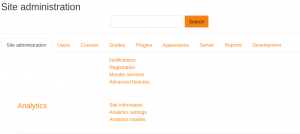Configuraciones de analítica
- Para administradores del sitio
- Modelos de analítica del aprendizaje
- Para profesores
- Para desarrolladores
- Para investigadores
Nota: Urgente de Traducir. ¡ Anímese a traducir esta muy importante página !. ( y otras páginas muy importantes que urge traducir)
El sistema de analítica del aprendizaje de Moodle requiere un poco de configuración inicial antes de que pueda ser usado. Usted puede acceder a Configuraciones de analítica desde Administración del sitio > Analítica > Configuraciones de analítica.
Información del sitio
¡Nueva característica
en Moodle 3.7!
La información del sitio será usada para ayudar a los modelos ae analíica del aprendizaje a que tomen en cuenta las características de la institución. Esta información también es reportada como parte de la recolección de datos del sitio al momento de registrar el sitio. Esto le permite al Cuartel General de Moodle comprender cuales áreas de la analítica del aprendizaje están siendo mpás utilizadas y priorizar apropiadamente los recursos para el desarrollo.
Configurar configuraciones de analítica del aprendizaje
The settings for the Moodle Learning Analytics system are set to reasonable defaults, but let’s review them. To configure and enable Moodle Learning Analytics settings, access the Analytics settings panel under Site Administration/Analytics.
Procesador de predicciones
Prediction processors are the machine learning backends that process the datasets generated from the calculated indicators and targets and return predictions. Moodle core includes 2 prediction processors:
- The PHP processor is the default. There are no other system requirements to use this processor.
- The Python processor is more powerful and it generates graphs that explain the model performance. It requires setting up extra tools: Python itself (https://wiki.python.org/moin/BeginnersGuide/Download) and the moodlemlbackend python package.. The latest version of the package for Moodle 3.7 is compatible with python 2.7 and python 3.4.
pip install "moodlemlbackend>=1.0.0,<2.0.0"
Almacén de bitácoras
From Moodle version 2.7 and up, the “Standard logstore” is the default. If for some reason you also have data in the older “legacy logs,” you can enable the Moodle Learning Analytics system to access them instead.
Intervalos de análisis
Analysis intervals determine how often insights will be generated, and how much information to use for each calculation. Using proportional analysis intervals allows courses of different lengths to be used to train a single model.
Each analysis interval divides the course duration into segments. At the end of each defined segment, the predictions engine will run and generate insights. It is recommended that you only enable the analysis intervals you are interested in using; the evaluation process will iterate through all enabled analysis intervals, so the more analysis intervals enabled, the slower the evaluation process will be.
Directorio de salida de modelos
This setting allows you to define a directory where machine learning backends data is stored. Be sure this directory exists and is writable by the web server. This setting can be used by Moodle sites with multiple frontend nodes (a cluster) to specify a shared directory across nodes. This directory can be used by machine learning backends to store trained algorithms (its internal variables weights and stuff like that) to use them later to get predictions. Moodle cron lock will prevent multiple executions of the analytics tasks that train machine learning algorithms and get predictions from them.
Trabajos agendados
Most analytics API processes are executed through trabajos agendados. These processes usually read the activity log table and can require some time to finish. You can find Train models and Predict models scheduled tasks listed in Administration > Site administration > Server > Scheduled tasks. It is recommended to edit the tasks schedule so they run nightly.



